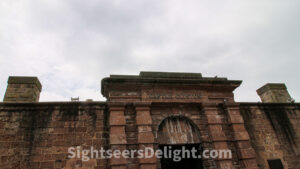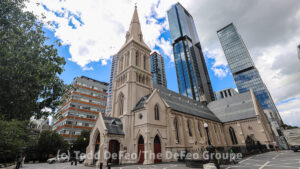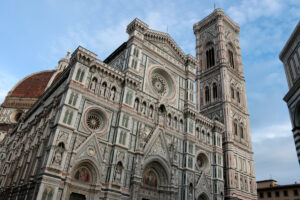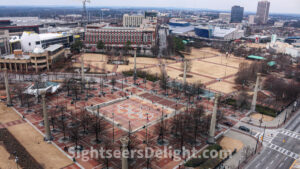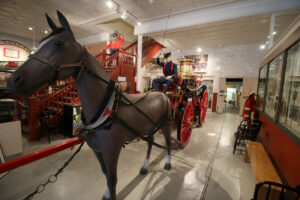
Guidebooks are annoying. Just because some editor who doesn’t know me tells me which restaurant is the best or what attraction is a must-see doesn’t make it a must-see attraction. Sightseers’ Delight is dedicated to the weird, the quirky and the fun. After all, traveling is fun.
If it’s not, you’re doing it wrong.
All of the places highlighted in this ever-growing database are great. Sightseers’ Delight has visited them all. We think you should make a point to see every one of them. But, this is not a guidebook. Just a webpage to help you plan your next adventure.
The Casimir Pulaski Monument stands in Monterey Square near the battlefield where Polish nobleman Casimir Pulaski died during the siege of Savannah. Pulaski, along with Michael Kovats de Fabriczy, is considered “the father of the American cavalry.” Workers laid the cornerstone for the monument in either 1825 or 1853, depending on the source. The monument’s inscription reads, “Pulaski, the Heroic Pole, who fell mortally wounded, fighting for American Liberty at the siege of Savannah, October 9, 1779.” On October 29, 1779, Congress passed a resolution that a monument should be dedicated to Pulaski, and the Savannah monument was the first monument in the United States dedicated to Pulaski.
Castle Clinton, also known as Fort Clinton and previously Castle Garden, is a circular sandstone fort located in what is today Battery Park. The structure sits roughly two blocks west of where Fort Amsterdam was built in 1626. At the time, New York City was still named New Amsterdam. Construction on Castle Clinton started in 1808 and finished in 1811; it was built on a small artificial island just offshore. The structure was America’s first immigration station and predates Ellis Island. More than 8 million immigrants passed through Castle Clinton while entering the United States between 1855 and 1890.
10004
The Cathedral Church of St. James is home to the oldest congregation in Toronto. Its parish dates to 1797 in what was then the city of York. Construction on the cathedral began in 1850; it was open for services starting in June 1853. It was one of the most massive buildings in the city at the time it opened.
The Cathedral of Saint Patrick and Saint Joseph, colloquially known as St. Patrick’s Cathedral, is the mother church of the Roman Catholic Diocese of Auckland and the seat of the Bishop of Auckland. Bishop Jean-Baptiste Pompallier acquired the land in 1841, and a wooden chapel was built in 1843. A stone church replaced the structure in 1848. The church expanded in 1884 and was replaced by the current cathedral in 1907. The church was designated as a cathedral in 1848 and consecrated in 1963. Heritage New Zealand registered the cathedral as a Category I historic place on Sept. 9, 1984.
The crown jewel of Florence is the Duomo Santa Maria del Fiore. The glorious cathedral dwarfs most other buildings in this city of about 356,000. Construction started in 1296 and was completed in 1436. Filippo Brunelleschi designed the famed dome. The building’s façade, generally described as a “neo-gothic façade of white, red and green marble,” is relatively new. It was completed in 1887 when the church was 591 years old.
Built on Aug. 6, 1952, this memorial dedicated to those who died in the bombing is the centerpiece of the city’s mission: Peace. The memorial includes a stone chest with the names of everyone who was killed in the bombing, and an inscription on it is generally translated to mean, “Let all the souls here rest in peace, for we shall not repeat the evil.”
The 21-acre park, today a centerpiece of downtown Atlanta’s tourist district, was built as a central green space and remains a popular place for outdoor events. The park, which helped positively transform downtown Atlanta, is surrounded by some of the city’s biggest tourist destinations, including the Georgia Aquarium and CNN Center.
30313
Located about two miles from Downtown Nashville, Tennessee, Centennial Park is perhaps best known for its Parthenon replica. The 132-acre park originally opened in 1903 where the Tennessee Centennial Exposition was held in 1897. The Parthenon replica was built for the Nashville pavilion of the Centennial Exposition, but since it was largely out of plaster and as a temporary exhibit building, the structure was rebuilt in the 1920s. Prior to Centennial Park, the area was a fairgrounds after the Civil War and the home of a race track known as West Side Park from 1884 to 1895.
The Center of the Universe is a unique concrete circle in Tulsa with an acoustic anomaly. The circle is a little over eight feet in diameter, and any noise inside it echoes loudly. However, only those inside the circle can hear the echo. Surprisingly, these loud sounds cannot be heard from outside the perimeter of the brick structure. Visitors can access downtown Tulsa’s Center of the Universe through a brick path leading visitors from the Boston Avenue pedestrian overpass.
74103
The Central Ohio Fire Museum & Learning Center opened in 2002 inside the restored historic Columbus Engine House (No.16) dating to 1908. In addition to historic engines and equipment, the museum aims to educate visitors about the dangers of fire and features a Safety Kitchen and a Safety Bedroom showing potential hazards and how to escape in an emergency.
43215

